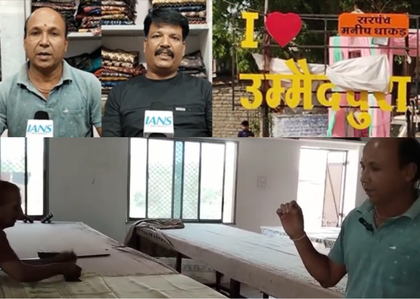Artisans of Ummedpura in Neemuch preserve a 400-year-old traditional art
By IANS | Updated: April 29, 2025 20:12 IST2025-04-29T20:09:22+5:302025-04-29T20:12:24+5:30
Neemuch (Madhya Pradesh), April 29 Ummedpura, a small village in Jawad tehsil of Madhya Pradesh's Neemuch district, has ...

Artisans of Ummedpura in Neemuch preserve a 400-year-old traditional art
Neemuch (Madhya Pradesh), April 29 Ummedpura, a small village in Jawad tehsil of Madhya Pradesh's Neemuch district, has carved out a global identity for its exquisite handicrafts. The village is renowned for its 400-year-old traditional art form - Nandana print - a block printing technique that uses 100 per cent natural dyes on pure cotton fabric.
This age-old art continues to thrive, thanks to the efforts of a few dedicated artisans. Brothers Banwari Jariya and Pawan Jariya, residents of Ummedpura, have been nationally recognised for their contribution to preserving Nandana printing. They were honoured with a national award for their craftsmanship and were invited to showcase their art at the G-20 summit in Delhi, hosted by Prime Minister Narendra Modi.
They have also initiated the process of securing a Geographical Indication (GI) tag for the art, which is currently in its final stages. Now, foreign customers even visit the village to purchase these handcrafted textiles. Nandana is a traditional block printing art native to Tarapur and Ummedpura and is among the few Indian handicrafts that still retain their original essence.
Historically, Bhil tribal women across Madhya Pradesh, Gujarat, Maharashtra, and Rajasthan wore garments printed with Nandana as a part of their traditional attire.
What sets Nandana apart is its use of natural dyes, clay treatment, and centuries-old wooden blocks inspired by elements of nature, giving the textiles a rustic, earthy charm. However, the art is now on the brink of extinction. At one time, the entire village of Ummedpura practised Nandana printing.
Today, only one family continues the tradition. With changing preferences, tribal women no longer wear the traditional lehengas, prompting artisans to shift focus toward sarees, salwar suits, dupattas, and bedsheets for the urban market, where demand remains strong.
Speaking to IANS, Banwari Jariya, a fifth-generation artisan, said: "This is our ancestral work. Earlier, the whole village was engaged in Nandana printing, primarily creating lehengas for tribal women. But over the past 10–12 years, demand has decreased, and many villagers have abandoned the craft. We now create items for urban markets using 100 per cent natural dyes. The process involves 18 steps and takes around 30 to 40 days to complete. The designs, known as ponchos, have distinct names, and the colour combinations are traditional and fixed."
Pawan Jariya added: "We have kept this 400-year-old tradition alive despite declining popularity. In 2017, I was awarded a national award by (Union Minister) Piyush Goyal for a bedsheet I created. I also had the opportunity to demonstrate our art at the G-20 summit, where I set up a stall and interacted with global guests. We are currently in the process of securing a GI tag, which will help us showcase our fading art form to the world."
Disclaimer: This post has been auto-published from an agency feed without any modifications to the text and has not been reviewed by an editor
Open in app